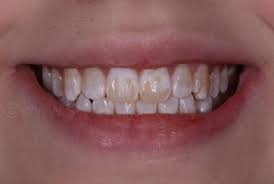We’ve all heard of the mighty fluoride building stronger, more cavity-resistant enamel for young and old teeth alike. But like most good things, too much is bad — and that goes for fluoride, too.
Excessive fluoride can cause fluorosis, a condition caused by ingesting more fluoride than the body needs. It can occur as skeletal fluorosis, where bones become weak and brittle, or dental fluorosis, where a child’s permanent tooth comes out discolored.
Dental fluorosis most commonly affects children during the time when their teeth and gums are still developing (usually before six or seven years of age), but only appears when the affected teeth have erupted. Chalky white lines or opaque white spots and patches appear — an indication of a mild form of fluorosis, the type that occurs among the majority of children with this condition in the U.S. Extreme cases turn the enamel yellow or brown, or worse, can cause a pitted tooth surface. This tooth discoloration is also called enamel mottling.
Practicing Prevention
Because fluoride is so easily available, it’s not hard to consume too much of it, specifically among children. Sources of fluoride may include:
- Tap water (city water)
- Toothpaste and mouth rinse
- Supplements such as drops, tablets and vitamins
- Certain foods like baby formula, infant food and some beverages manufactured in cities with fluoridated water
Even though it can be easy for kids to get too much fluoride, there are ways to keep from going overboard. Here are a few simple steps to prevent fluorosis:
- Use unfluoridated baby tooth cleanser for kids younger than 2 years — ask your dentist for a recommendation
- Train your child with good brushing and rinsing habits to minimize swallowing toothpaste
- When using fluoridated toothpaste, make sure to place only a drop (as tiny as a green pea) for kids up to 8 years of age
- Before giving children additional fluoride supplements or a fluoride dental treatment, account for all sources of fluoride they may be getting
- Take care in using fluoridate water with your baby’s formula until after he or she is a year old, but do consult with a physician or pediatrician
Damage Control
Prevention is indeed better than cure, especially with fluorosis — the damage it can cause is permanent. But there is hope — various dental treatments are available to hide the damaged teeth surface:
Abrasion — This can be used when the fluorosis is mild, because it only involves thinly sanding the enamel’s outer layer.
Composite Bonding — The dentist applies a tooth-colored composite resin to the tooth and bonds the material to the tooth using a special light.
Dental Veneers — Veneers are thin porcelain shells that are attached to existing teeth.

